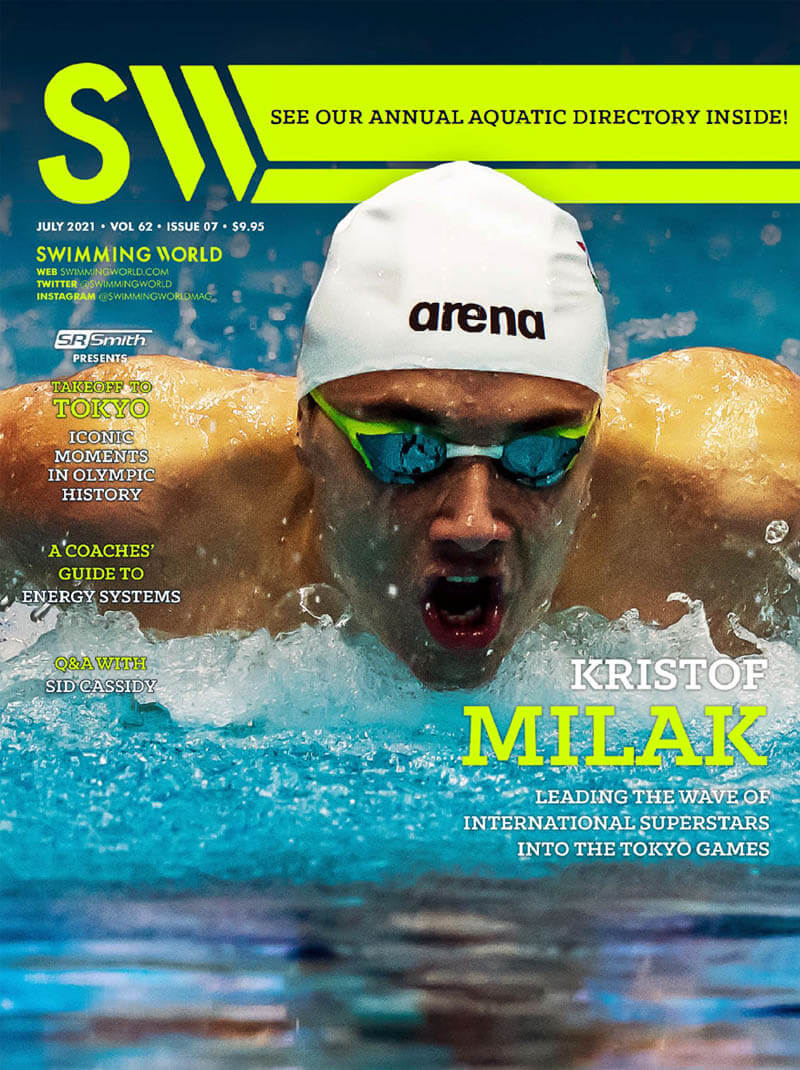Swimming World Presents – How They Train: St. Andrews’ Megan Moroney and Aspen Gersper – Sponsored By StrechCordz

The latest issue of Swimming World Magazine
is now available for download in the Swimming World Vault!
Non-Subscribers Can Download This Issue Here
How They Train: St. Andrews’ Megan Moroney and Aspen Gersper
By Michael J. Stott
While not mirror images, the traits of two of Sid Cassidy’s more successful swimmers are strikingly similar: versatile (breaststroke-challenged), uber competitive, won two Florida high school titles as ninth-graders, national-level abilities, terrific relay swimmers and great students who survived disruptive health issues. One, Megan Maroney, graduated from college in 2020; the other, Aspen Gersper, is still in high school.
MEGAN MARONEY
Moroney got her first Olympic Trials cut at age 14 in the 100 backstroke and contributed heavily to Saint Andrew’s 2011 junior national title (with only four girls). She completed her college career at the University of Virginia as a 17-time CSCAA All-American and 11-time All-ACC honoree, and is listed on the Cavaliers’ top 10 times list in the 50-100-200 free and 100- 200 back.
During her early teens, Moroney’s training was aerobically focused. In high school, Cassidy began refining her speed: “At 14, I remember her racing a set of LCM freestyle 400s. We had a group of decent older males who had not yet been challenged by her. She crushed the set, and the boys never took her lightly again. She made our team so much better.”
Says Moroney, “I’m so thankful for the time I had at Saint Andrew’s. I don’t think I would have had the college career I did without it. Saint Andrew’s is filled with amazing people who had such a positive impact on the person and athlete I became. Every friend I made, every race I swam, every practice I grinded through, every 5 a.m. alarm, every lesson I learned—I am grateful for every single memory.”
ASPEN GERSPER
Aspen Gersper just competed in Wave 1 of the U.S. Olympic Trials. Her swims in the 100 free and 100 back were a continuation of an outstanding COVID-influenced season in which she won FHSAA titles in the 100 yard back (54.51) and 100 fly (54.28) and an NCSA 13-14 age group crown in a meet record 50 back (26.00).
“We were thrilled to see Aspen gain so much experience at Wave 1 Olympic Trials,” said Cassidy. “I was quite happy to see her moving up the ranks, holding her own and competing so well with so many older female swimmers. It was a good step forward and will prove quite valuable in
the years to come.”
Here’s a typical Gersper SCY training set: 3x the following:
• 2 x 125 free/stroke/free/stroke/free @ 1:40
• 2 x 75 @ 1:20 (hold best average)
• 2 x 125 free/stroke/free/stroke/free @ 1:40
• 4 x 50 stroke at 200 pace @ 1:00
• 2 x 125 free/stroke/free/stroke/free @ 1:40
• 8 x 25 at 200 pace @ :25 (hold stroke count)
• 1 x 100 easy
After Round 3:
• 200 all-out race for time!
“Most Saturday mornings, we do a LCM test set and bring in the Gold with our Platinum swimmers, treating it like a meet simulator,” says Cassidy. “We typically assign a meet-type warm-up and then dive anywhere from four to eight all-out races, keeping it festive, and finish each week FAST,” says Cassidy.
“We generally cycle in our LCM training MWF mornings 5:30-7:30 a.m. and Thursday afternoons 4-6 with Saturday mornings during the school year. We go to all LCM mornings in summer: 2.5 hours. We follow up with doubles Monday through Thursday, keeping our Saturdays open for test sets or meets.”
Michael J. Stott is an ASCA Level 5 coach, golf and swimming writer. His critically acclaimed coming-of-age golf novel, “Too Much Loft,” was published in June 2021, and is available from Bookbaby.com, Amazon, B&N and book distributors worldwide.
Click here to download the full issue of Swimming World July 2021, available now!
Get Swimming World Magazine and Swimming World Biweekly FREE When You
Become A Member of the International Swimming Hall of Fame
New! 30 Day Membership to ISHOF AND Digital Swimming World Subscription for just $10 a month!
Want more? Get a 1 Year ISHOF Family Membership With Swimming World Print AND Digital Subscription Order Now!
Non-Subscribers can click here to download this issue for only $5.94
FEATURES
010 | TOKYO OLYMPIC GAMES: READY FOR IMPACT
by Dan D’Addona, Matthew De George, John Lohn, David Rieder and Andy Ross
As the United States was still selecting its Olympic swimming team in mid-June, most countries had already decided who would be competing at the COVID-19 pandemic-delayed Olympic Games this summer. Here are profiles of 10 swimmers from around the world who have been preparing to make an impact in Tokyo.
022 | TAKEOFF TO TOKYO: ICONIC MOMENTS IN OLYMPIC HISTORY
by John Lohn
In October of 2019, nearly a year prior to the original date of the 2020 Olympic Games in Tokyo, Swimming World designed a series that would pay homage to the history of the sport on its biggest stage. For our final installment of “Takeoff to Tokyo,” we offer a look at some of the most prominent moments in Olympic lore.
026 | AS GOOD AS IT GETS
by Dan D’Addona
In our Olympic preview of artistic swimming, Swimming World notes that Russia is a perfect 10-for-10, winning every Olympic gold medal possible—duet and team—since the turn of the century. Led by Svetlana Romashina and Svetlana Kolesnichenko, Russia will be tough to beat next month, Aug. 2-7, in Tokyo.
COACHING
20 | SWIMMING TECHNIQUE CONCEPTS: MAXIMIZING SWIMMING VELOCITY (Part 3)—MINIMIZING THE ARM ENTRY PHASE TIME IN FREESTYLE AND BUTTERFLY
by Rod Havriluk
The non-propulsive time in a stroke cycle consists of the time for the entry phase and the recovery phase. This article presents strategies to minimize the entry phase time for freestyle and butterfly so that a swimmer can decrease stroke cycle time, increase stroke rate and increase swimming velocity.
040 | A COACHES’ GUIDE TO ENERGY SYSTEMS (Part 2)
by Michael J. Stott
Last month, Swimming World explored the concept of energy systems and how coaches can use them to maximize athlete development and performance. In Part 2, we examine how one incorporates his understanding of energy systems into a seasonal training plan.
042 | Q&A WITH COACH SID CASSIDY
by Michael J. Stott
043 | HOW THEY TRAIN MEGAN MORONEY AND ASPEN GERSPER
by Michael J. Stott
TRAINING
019 | DRYSIDE TRAINING: SUMMER SPEED
by J.R. Rosania
JUNIOR SWIMMER
45 | UP & COMERS: KAYLA HAN
by Shoshanna Rutemiller
COLUMNS & SPECIAL SECTIONS
008 | A VOICE FOR THE SPORT
018 | THE OFFICIAL WORD
027 | 2021 AQUATIC DIRECTORY
046 | GUTTERTALK
047 | PARTING SHOT
Swimming World is now partnered with the International Swimming Hall of Fame. To find out more, visit us at ishof.org





